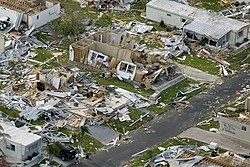Hurricane Charley
Hurricane Charley was the second hurricane and also the second major hurricane (category 3+) of the 2004 Atlantic hurricane season. Charley lasted from August 9 to August 15. Its strongest winds were 150 mph (240 km/h), classifying it as a Category 4 hurricane on the Saffir-Simpson Hurricane Scale. The storm made landfall in southwestern Florida. It was the strongest hurricane to hit the United States since Hurricane Andrew, twelve years earlier. In the United States, Charley caused ten deaths and $15.4 billion in damage (2004 USD).
| Category 4 major hurricane (SSHWS/NWS) | |
 Hurricane Charley before landfall in Florida | |
| Formed | August 9, 2004 |
|---|---|
| Dissipated | August 15, 2004 |
| Highest winds | 1-minute sustained: 150 mph (240 km/h) |
| Lowest pressure | 941 mbar (hPa); 27.79 inHg |
| Damage | $16.3 billion (2004 USD) |
| Areas affected | Jamaica, Cayman Islands, Cuba, Florida, South Carolina, North Carolina |
| Part of the 2004 Atlantic hurricane season | |
The destruction from Hurricane Charley
Charley did its damage in a very similar manner to Andrew: high winds caused almost all the damage, and both storms made landfall at low tide, preventing the storm surges from causing damage like they usually do when hurricanes make landfall. Both were compact storms upon landfall.
Hurricane Charley Media
Charley making landfall on August 13, 2004
Damage in Captiva Island
Damage caused to a gas station by Hurricane Charley in Kissimmee.
President George W. Bush, aboard Marine One, surveys hurricane damage at a mobile home park in Fort Myers.
Aerial image of destroyed homes in Punta Gorda
Empty railroad hopper cars toppled over as a result of high winds from Hurricane Charley in Fort Meade
Charley making landfall near North Myrtle Beach, South Carolina








